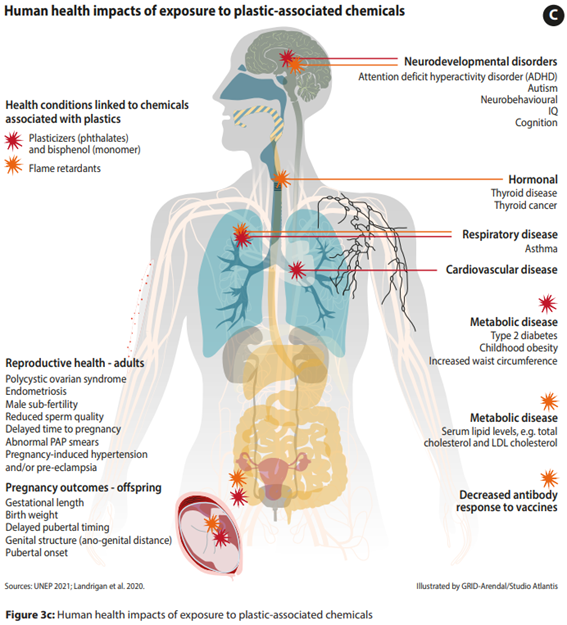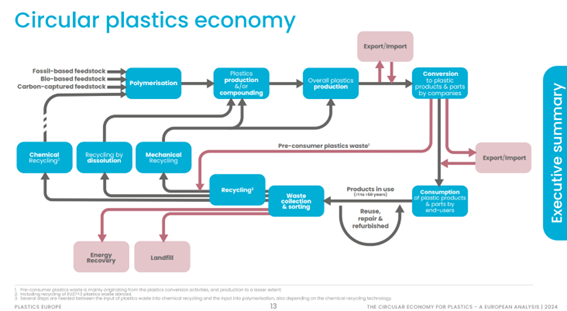
Workers are overwhelmed cleaning up the sea of plastic waste that washes ashore and clogs coastlines. Image: Pew Charitable Trusts Magazine, Fall 2020
By Mariana Meneses
There has been an alarming increase in plastic waste in the past twenty years, and new technologies are emerging that could tackle the problem head-on.
According to the OECD’s Global Plastics Outlook report, global annual plastic waste production has surged from 180 million to nearly 400 million tonnes in just two decades, with projections to triple by 2060. In 2060, about half of plastic waste is expected to end up in landfills, with less than 20% being recycled.
Packaging contributes nearly 40% of global plastic waste, making its reduction and recycling a critical focus in addressing plastic pollution. A 2022 Ipsos survey revealed that 70% of respondents across 34 countries support international standards to ban single-use plastics. EuroNews reports that many countries have successfully implemented bans or taxes on single-use plastic bags, with over 100 nations adopting such policies.

Image: Statista
An increased global focus on plastic reduction, and innovative new scientific processes to break down and reuse plastics, are addressing the problem, but more is needed.
Efforts like single-use plastic bans and taxes, especially in Africa, Asia, and Europe, have significantly reduced plastic waste. In places like California, plastic bag use has dropped by over 70%, while Ireland saw a 90% reduction due to taxation. Public response to these measures has been largely positive, with visible environmental benefits, such as fewer plastic items found during beach cleanups.
Breaking the Plastic Wave | Pew
Plastic waste continues to outpace efforts to mitigate the global problem.
The expected tripling of plastic waste by 2060 is being driven by population and economic growth, with recycling rates improving only slightly. Most waste will still end up in landfills or be incinerated, especially in developing countries with poor waste management. The OECD report stresses the need for better policies to reduce plastic use, promote reuse, and advance recycling technologies.

Image: Statista
The Circular Economy for Plastics – A European Analysis 2024 focuses on extending the life of plastics through reduction, reuse, and recycling, keeping them out of landfills and oceans while reducing CO2 emissions. The 2022 “ReShaping Plastics” report highlights circularity as the quickest, most cost-effective, and most reliable way to reduce plastic waste and greenhouse gas emissions from the plastics industry.
The report notes that plastics with a circular life now make up 13.5% of all plastic resins in Europe, with recycling rates reaching 26.9% in 2022, surpassing landfill for the first time. However, incineration has risen by 15% since 2018, and 25% of plastic waste still ends up in landfills. To meet the goal of achieving 25% circular plastics by 2030, further investment in recycling infrastructure and technology is essential, along with addressing Europe’s competitiveness gap in the circular plastics economy.
By 2050, plastic is expected to outweigh all fish in the seas.
Plastic pollution is a major threat to the oceans, with an estimated 75 to 199 million tons of plastic waste currently in marine environments, according the UN Environment Programme. Each year, 8-10 million metric tons of plastic enter the oceans. Plastic waste makes up 80% of marine pollution, primarily from single-use items like bags, bottles, and food wrappers. Asia contributes 81% of ocean plastic, with the Philippines being the top source. The impact on marine life is severe, with 100% of marine turtles and 59% of whales affected.
The UN’s From Pollution to Solution: A global assessment of marine litter and plastic pollution also explains in detail how human exposure to micro and nano plastic particles occurs on a daily basis.

UN’s From Pollution to Solution: A global assessment of marine litter and plastic pollution.
Microplastics are in our system and may accumulate in organs; we inhale and ingest them, while they also penetrate our skin.

UN’s From Pollution to Solution: A global assessment of marine litter and plastic pollution.
Microplastics are in the air, in water, beer, sugar, personal care products and seemingly almost everywhere.

UN’s From Pollution to Solution: A global assessment of marine litter and plastic pollution.
Microplastics have been connected to many health consequences for humans such as diabetes, asthma, ADHD, thyroid cancer, and more. If plastic is everywhere, what are some of newly proposed solutions to the risks it poses?
Biodegradable living plastics hold promise for a greener future.
Traditional plastics are difficult to degrade, creating significant ecological challenges. A new study, published in the journal Nature Chemical Biology by Chenwang Tang, from the Chinese Academy of Sciences, and co-authors, proposes a solution: Degradable Living Plastics.
The scientists have created biodegradable plastics by combining biology and polymer sciences. They use engineered spores from a bacterium called Bacillus subtilis and embed them into plastic materials. These spores are designed to produce an enzyme called BC-lipase when they come into contact with a substance called xylose. The spores are mixed with a biodegradable plastic called poly(caprolactone) to make different types of plastic without affecting their strength or durability. The plastic starts to break down when the spores on the surface are activated, releasing the enzyme, which then helps decompose the plastic.
The study presents a potential solution for developing sustainable and green plastics that can remain stable during use and degrade when triggered.
A new catalytic process that vaporizes plastic waste could be an important solution for the recycling problem.
A new catalytic process breaks down common plastics like polyethylene (used for flexible plastics like single-use bags) and polypropylene (used in hard plastics like microwaveable dishes) into their basic components, which can be reused to create new plastic materials. This method could help establish a circular economy for most consumer plastics, cutting down on both the need for petroleum-based production and the amount of plastic waste.
Researchers at the University of California Berkeley have developed a catalytic process that vaporizes plastics into reusable hydrocarbon building blocks for new plastics.
Plastics to Building Blocks | UC Berkeley
Earlier processes used expensive and sensitive catalysts, but the new method uses cheaper, more durable solid catalysts — sodium on alumina and tungsten oxide on silica — which are commonly used in the chemical industry.
The process works efficiently on polyethylene and polypropylene. These two plastics make up about two-thirds of global post-consumer plastic waste. The process converts up to 90% of polyethylene and polypropylene into propylene and isobutylene, showing high efficiency even with small plastic impurities. Researchers suggest that the method could be scaled up for industrial use, helping tackle plastic waste for decades to come.
It’s worth noting that the new method does not work as well with every type of plastic. For instance, small amounts of PET (Polyethylene Terephthalate) and PVC (Polyvinyl Chloride) plastic significantly reduce the efficiency of the process. But the researchers believe this is not a big issue, as current recycling methods already separate these plastics.
There is an increased focus on a circular economy for plastics.
The process aims to establish a circular economy by turning plastic waste into monomers, which are small, simple molecules that, when joined together, form larger, more complex molecules called polymers.
This can reduce the need for fossil fuels used in the production of plastic and minimizing environmental damage. While new, easily recyclable materials are being developed, this process addresses the immediate problem of dealing with the vast amounts of existing, hard-to-recycle plastics.
Addressing the growing plastic waste crisis requires a multifaceted approach. While global plastic waste continues to surge, innovative solutions are emerging. Efforts to reduce plastic use, such as bans and taxes on single-use items, have shown promising results in many regions.
The rise of circular economy strategies, including the development of biodegradable plastics and new catalytic processes for recycling, offers hope for mitigating the environmental impact of plastics.
These advancements, combined with continued investment in recycling infrastructure and technology, are crucial for creating a sustainable future. However, sustained global commitment and action are essential to achieving long-term success in reducing plastic waste and protecting our environment.
We would love to hear what you think of this article.
☞ Click here to complete our 2-minute Reader survey.
Craving more information? Check out these recommended TQR articles:
- Progress in Superconductivity Holds Promise for Clean Energy, Medicine, Quantum Computing, and More
- Advances in Nuclear Fusion Technology are Fueling the Dream of Limitless Clean Energy
- Clean Technologies and Technologies That Clean: Undoing the Climate Damage We Have Caused
- Harnessing Ocean Power: New Technologies Hold Promise for Clean and Cost-Effective Energy
- In Wiki Loves Earth Photos, Observers Share a Deep Knowledge of Nature’s Incredible Integration




